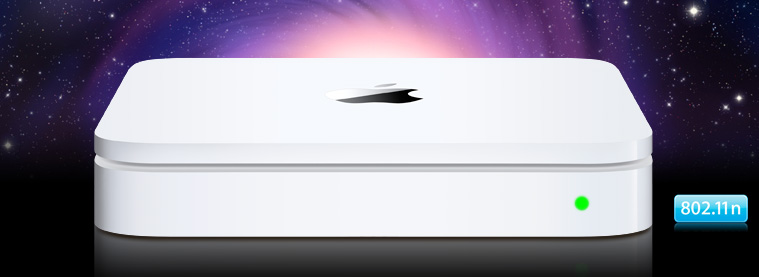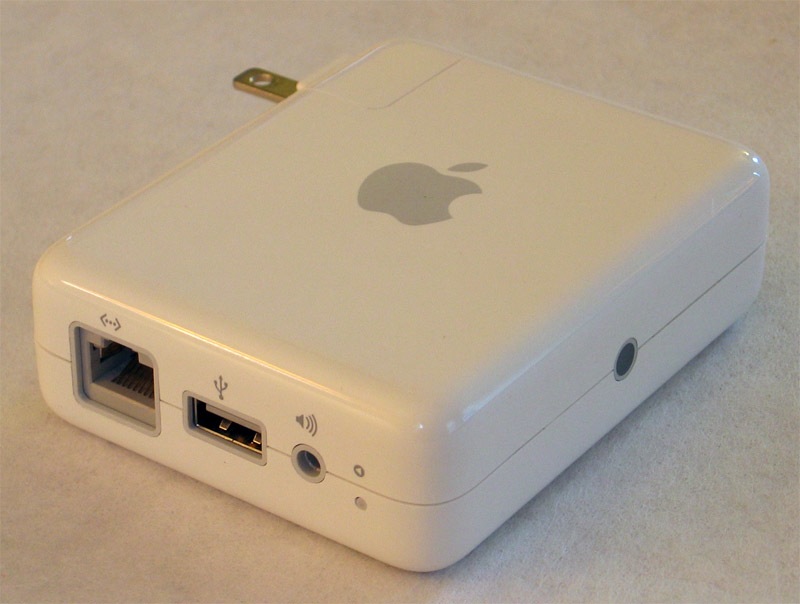Sometimes I am amazed at how confused I can get over WLAN configurations. What seems so straightforward and plain to me when I am advising someone else will appear convoluted and unknowable when it is my own configuration.
Take for example my own humble home network. Over the years it has evolved from a single
Apple Airport (Graphite) Base station and a laptop back in 1999 which I still own to my rather complex hodgepodge of multiple networks I have today.
Today I have 3 networks which I have re-architected many times based on my own changing needs. One for media (music and in the future, Apple TV), one for testing and one for primary wireless access.
The network used only for music (
AirTunes is Apple's name for it) consists of one
Apple AirPort (Snow) Base Station on my Ethernet LAN and several
AirPort Express wireless repeaters scattered liberally throughout my home attached to stereos and speakers here and there. The purpose of these are, as I already mentioned, is to provide me with ubiquitous and simultaneous music. They are all on channel 1 (2.412 gHz) so as to avoid the old Sharp Carousel microwave oven which would normally destroy my listening enjoyment when it is running if the network would use channels 5 to 13 (2.432 - 2.472 gHz). Happily this network has an option set that will not permit Clients (STAs) to attach to it and in fact does not appear on my AirMagnet WiFi analyzer except as actual 802.11 packets. The APs themselves are invisible to network scanners like Netstumbler and others unless you actually do packet analysis. Lastly it is encrypted with WPA2-PSK and is configured for 802.11g only with a 5.5Mb/s muticast rate so the music will play without skips or misses as it streams from my music server.
.
The testing network changes constantly and has AirMagnet Sensors and the Meraki nodes on it. You may have seen some of my previous posts about Meraki's cloud based wireless solutions. Very cool indeed

Now onto the primary network and here is where I got confused. You see, originally this was an 802.11b/g network using that old AirPort (Snow) Base Station. However, as a WLAN engineer I felt it important to have an 02.11n network in place but was worried about interference. This would be both co-channel and adjacent channel interference from other wifi devices as well as non-wifi interference from cordless phones, Bluetooth and my dreaded microwave oven. So I purchase the Airport Extreme Base Station N.This device supported both 802.11a/b/g and Draft N standards, it had Gigabit Ethernet and a port to connect a USB hard drive for NAS. However, I was extremely disappointed to learn that this device would only work on either 5gHz or 2.4gHz not both simultaneously. I wanted both at the same time. C'est la vie. I put the AP in place and started to have issues with the configuration right away. You see, I wanted to use the older Express devices as wirelessly connected repeaters as I had the the other AP but after 2 weeks of trying I could never get them to work so I figured that Apple must want me to upgrade them to the newer N model, however I was reluctant as there was nothing wrong with the ones I had. I chose to live with it the way it was.
Luckily for me Apple introduced a Simultaneous Dual Band version within a few weeks of my purchase and I was able to exchange mine for the newer model. This turned out to cause a new problem when I noticed that it was dropping client occasionally and had to be rebooted once or twice a week. I was perturbed and figured the problem was me or my configuration. I twiddled the settings a few times and changed the firmware but had limited success resolving my issues. I did notice that the Ethernet connectors were always loose no matter how firmly I inserted them but could not positively determine if this was the issue. Also, I suspected my aging ZyXEL DSL router to be a culprit but again could not reproduce the problem to my satisfaction. I just could not believe that it was an Apple product control issue. My internal standard for Apple's Quality control was very high after years and years of experience with their products. Finally, after awhile (2-3 moths) I grew tired of trying to fix it and gave up and just informed my family to reboot the Internet Router and the Airport if they couldn't access the Internet. To quote Julia Child,
"This always works."After a few months and independent from these issues, we decided to invest in a backup solution that was more comprehensive that the piece meal attempts at backup we were doing today. The consensus was to go with
Apple's TimeCapsule as I had heard from others on how well it performed. For all intents and purposes it was identical to my current AP but with internal Hard Drive and Power supply so I was a bit trepidatious but gave it the green light. We purchased the product. Configured it in about 15 minutes and replaced the Simultaneous Dual-Band AirPort Extreme N Base Station and low and behold, all my problems went away! I was amazed and decided that 8 hours was not long enough for testing. 2 weeks later it is still going strong. I had found the weak link, or had I?
I repurposed the Slightly older AirPort to my boudoir/office and never had a problem again with either connections. To this day I am at a loss to explain it. Some combination caused the problem, once separated however, the problem disappeared.
You see, sometimes I get confused.






